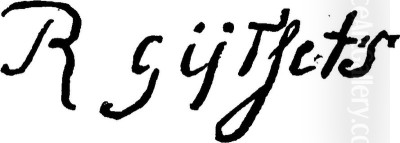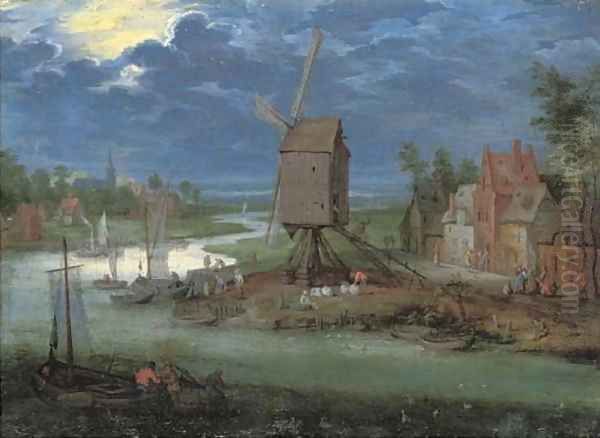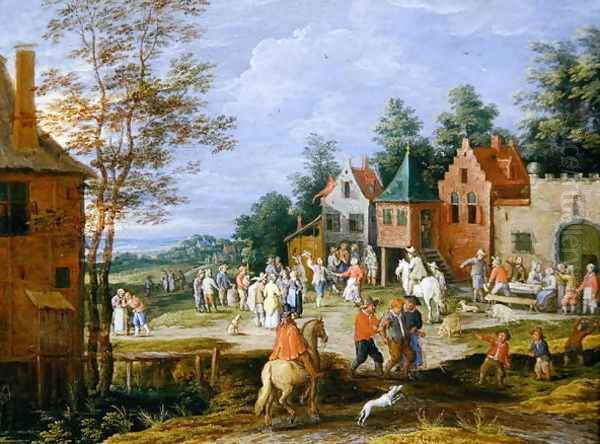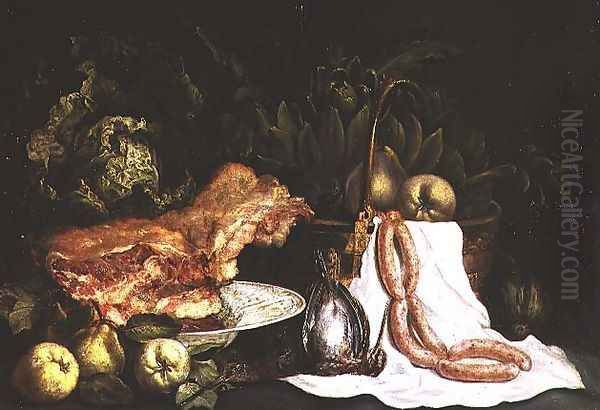
Pieter Gysels (1621-1690) stands as a notable figure in the rich tapestry of Flemish Baroque art. Born and deceased in the bustling artistic hub of Antwerp, Gysels carved a niche for himself with his meticulously detailed landscapes, engaging architectural scenes, and vibrant still life compositions. His work, deeply imbued with the spirit of his time, reflects both the technical prowess and thematic concerns of 17th-century Flemish painting, particularly echoing the enduring legacy of the Brueghel dynasty.
Early Life and Artistic Formation in Antwerp
Born in 1621, Pieter Gysels entered an Antwerp that, while past its absolute zenith as the primary economic power of Northern Europe, remained a preeminent center for artistic innovation and production. The city was home to the prestigious Guild of Saint Luke, an organization that regulated and fostered the talents of painters, sculptors, and artisans. It was within this environment that Gysels would develop his skills.
While concrete documentary evidence of Gysels' formal apprenticeship is scarce, the stylistic qualities of his work offer compelling clues. His paintings, especially those depicting lively village markets, kermesses (summer fairs), and bustling rural scenes, bear an undeniable resemblance to the works of Jan Brueghel the Elder (1568-1625), often nicknamed "Velvet" Brueghel for his smooth, refined technique and rich colours. The Elder Brueghel was a towering figure, celebrated for his paradisiacal landscapes, allegorical scenes, and flower still lifes, often populated with myriad small figures.
The Brueghelian Influence
The influence of Jan Brueghel the Elder on Gysels is profound and multifaceted. It's seen in the panoramic scope of some landscapes, the meticulous attention to detail in flora and fauna, and the vibrant depiction of peasant life. Gysels adopted the Elder Brueghel's penchant for creating miniature worlds teeming with activity, where every figure, animal, and object is rendered with care.

Given the chronological gap, it's unlikely Gysels studied directly under Jan Brueghel the Elder, who passed away when Gysels was only four years old. However, the art world of Antwerp was tight-knit, and the Brueghel workshop and style remained immensely popular and influential. It is more plausible, and indeed speculated by art historians, that Gysels may have had a closer connection with Jan Brueghel the Younger (1601-1678), the son of Jan Brueghel the Elder. The Younger continued his father's workshop and artistic traditions, producing works that were often stylistically indistinguishable from his father's. The striking similarity in their handling of kermesses and market scenes has led scholars to suggest that Gysels might have worked alongside or learned from Jan Brueghel the Younger. This connection would have provided Gysels with direct access to the Brueghelian techniques, compositions, and thematic repertoire.
Other artists from the Brueghel lineage, such as Pieter Bruegel the Younger (c. 1564-1638), who specialized in popularizing his father Pieter Bruegel the Elder's compositions of peasant life, also contributed to the artistic environment that shaped Gysels. The broader Brueghel family, including Ambrosius Brueghel and Jan Peeter Brueghel (another son of Jan Brueghel the Younger), ensured that this particular style of detailed, narrative painting remained a dominant force in Antwerp.
Entry into the Guild of Saint Luke
A significant milestone in any Antwerp artist's career was acceptance as an independent master into the Guild of Saint Luke. This not only conferred official recognition of their skill but also granted them the right to establish their own workshop, take on apprentices, and sell their works independently. Pieter Gysels achieved this status in 1648 (some sources cite 1649-1650, but 1648 is frequently mentioned), marking his official entry as a professional painter in the competitive Antwerp art scene. This achievement underscores his established skill and reputation by his late twenties.
The Guild of Saint Luke in Antwerp was a venerable institution, with members like Peter Paul Rubens, Anthony van Dyck, and Jacob Jordaens having passed through its ranks. For Gysels, becoming a master meant he was now part of this esteemed lineage, contributing to Antwerp's continued artistic output.
Artistic Style and Thematic Focus
Pieter Gysels was a versatile painter, though his reputation primarily rests on his landscapes and genre scenes, with still lifes forming another important part of his oeuvre.
Landscapes and Village Scenes
Gysels' landscapes are quintessential examples of the Flemish tradition, often depicting idyllic countryside settings, river views, and woodland scenes. These are rarely empty vistas; instead, they are animated by human activity. His village scenes are particularly noteworthy, capturing the communal life of the peasantry with charm and vivacity. These works often feature:
Kermesses and Markets: Following the Brueghelian model, Gysels excelled in depicting bustling village fairs, markets, and celebrations. These paintings are characterized by a multitude of small, anecdotally rendered figures engaged in various activities – dancing, drinking, trading, conversing, and playing games. The scenes are typically set in open village squares or along riverbanks, often with distinctive architectural elements like churches or inns providing a backdrop.

Detailed Staffage: The figures (staffage) in his landscapes, though small, are rendered with individual character and contribute to the overall narrative. He populates his scenes with peasants, gentry, animals, and carts, creating a dynamic and engaging visual experience.
Lush Vegetation and Atmospheric Effects: Gysels paid close attention to the natural world, rendering trees, foliage, and water with a delicate touch. His use of colour and light helps to create a sense of depth and atmosphere, often evoking the specific light of different times of day or seasons.
Architectural Works
While not an architectural painter in the specialized sense of artists like Pieter Neefs the Elder or Hendrik van Steenwijck the Younger (who focused on church interiors or imaginary palaces), Gysels incorporated significant architectural elements into his landscapes and village scenes. These buildings – cottages, farmhouses, village churches, inns – are rendered with an eye for their rustic character and structural detail, providing a convincing setting for the human activities he depicted. They are integral to the composition, anchoring the scenes and adding to their narrative richness.
Still Life Paintings
Gysels also produced exquisite still life paintings, a genre that flourished in the Low Countries during the 17th century. His still lifes often feature arrangements of flowers, fruits, vegetables, game, and tableware, demonstrating his skill in rendering diverse textures, colours, and the play of light on different surfaces.
Pronkstillevens (Ostentatious Still Lifes): Some of his still lifes lean towards the "pronk" style, showcasing an abundance of luxurious items, though perhaps not with the overt opulence of specialists like Abraham van Beyeren.
Game Pieces and Kitchen Scenes: He was adept at painting game pieces, similar in theme to the works of Frans Snyders or Jan Fyt, though often on a smaller, more intimate scale. These might depict dead birds, hares, and other hunting trophies, sometimes combined with vegetables and kitchen utensils, hinting at a kitchen or larder setting.
Meticulous Detail: Consistent with his landscape work, Gysels' still lifes are characterized by meticulous detail and a refined finish. Each element is carefully observed and rendered, contributing to a harmonious and visually appealing composition. The influence of artists like Osias Beert the Elder or Clara Peeters, early pioneers of Flemish still life, can be discerned in the careful arrangement and detailed execution.
Representative Works
Several works exemplify Pieter Gysels' style and thematic preoccupations:

"River Landscape": This title likely refers to a common theme in his oeuvre. Such paintings would typically feature a broad river, often with boats, flanked by wooded banks or villages. Figures would be engaged in activities like fishing, travelling by boat, or relaxing on the riverbanks, all rendered with his characteristic detail and atmospheric sensitivity.
"A Coach at a Village Crossroads" (or similar titles like "Village Road with a Carriage"): This subject allows Gysels to combine his skills in landscape, architectural rendering, and figural depiction. One can imagine a scene with a dusty road, perhaps a prominent inn or a few cottages, and a horse-drawn carriage as a focal point, surrounded by villagers and travellers. Such a work would capture the everyday comings and goings of rural life.
"Figures dancing in a Village Scene" (also known as "Peasants merrymaking on a Village Street" or "A River Landscape with Gentry and Peasants dancing on a Quay"): This is a classic Gysels theme, directly in the Brueghelian tradition. These paintings are vibrant and energetic, often depicting peasants dancing to the music of fiddlers or bagpipers, usually outdoors, perhaps near a tavern or under trees. The joy and exuberance of the kermesse are palpable, with numerous small figures contributing to the festive atmosphere. One such example, often cited, is "Village Scene with Dancing Figures," which portrays a lively gathering on the edge of a village, with trees framing the view and musicians providing the rhythm for the dancers.
"Still Life with Vegetables, Meat, Fruit and Game": This title points to his skill in the still life genre. Such a composition would showcase a rich assortment of foodstuffs, meticulously arranged and rendered. The textures of rough-skinned vegetables, glistening fruits, plucked fowl, and perhaps a hare or other game would be contrasted, demonstrating Gysels' virtuosity in capturing the tactile qualities of different objects. These works often carry underlying themes of abundance or vanitas, common in still life painting of the period.
His works are appreciated for their bright palettes, fine brushwork, and the charming, almost jewel-like quality of their execution.
The Artistic Milieu of Antwerp and Contemporaries
Pieter Gysels operated within a vibrant and competitive artistic community in Antwerp. While the towering figures of Rubens and Van Dyck had passed their peak influence or were deceased by the time Gysels matured as an artist, their legacy, and the city's strong painting traditions, persisted. Gysels was part of what is sometimes termed the "Antwerp school of minor masters" – highly skilled painters who specialized in particular genres and often catered to a burgeoning middle-class market as well as aristocratic patrons.
Several contemporaries and near-contemporaries are relevant to understanding Gysels' context:
David Teniers the Younger (1610-1690): A hugely successful and influential painter of peasant scenes, kermesses, guardroom scenes, and alchemist laboratories. Teniers' lively and often humorous depictions of everyday life were immensely popular and set a standard for genre painting. Gysels' village scenes share thematic similarities with Teniers, though Gysels often maintained a more Brueghelian delicacy.
Adriaen Brouwer (1605/6-1638): Though his career was short, Brouwer was a master of depicting raw, expressive peasant life, often in tavern interiors. His work influenced Teniers and others.
Joos de Momper (1564-1635): A leading landscape painter who often collaborated with Jan Brueghel the Elder (who would paint the staffage in de Momper's landscapes). His panoramic and often fantastical mountain landscapes represent an important facet of Flemish landscape tradition.
Frans Snyders (1579-1657) and Jan Fyt (1611-1661): These were the preeminent masters of animal painting and large-scale still lifes, particularly hunting scenes and market stalls laden with game and produce. Gysels' smaller game pieces exist within this broader tradition.
Adriaen van Utrecht (1599-1652): Another prominent still life painter, known for his lavish pronkstillevens and market scenes.
Gonzales Coques (1614/18-1684): Known as the "little Van Dyck," Coques specialized in elegant small-scale group portraits and "conversation pieces."
Hiëronymus Janssens (1624-1693): Known as "Den Danser" (The Dancer), Janssens specialized in elegant interior scenes with figures dancing or making music, often depicting fashionable society. There is a record of Gysels and Janssens being involved in an art-related event together on September 14, 1687, suggesting professional association, though extensive collaboration on paintings is not widely documented for Gysels.
Jacob van Arthois (1613-1686): A prominent landscape painter known for his woodland scenes, who sometimes collaborated with other artists like David Teniers the Younger for the staffage.
Hendrik van Steenwijck the Younger (c.1580-1649): A specialist in architectural interiors, particularly churches, continuing a family tradition.
Philippe de Champaigne (1602-1674): Though primarily active in Paris, this Brussels-born painter was a contemporary whose sober and dignified portraits and religious scenes offer a contrast to the more exuberant Flemish styles.
Willem van Aelst (1627-1683): A Dutch still life painter who also worked in France and Italy, known for his elegant flower pieces and hunting still lifes. His refinement offers a point of comparison for Gysels' own detailed still lifes.
The panel maker Melchior de Bout is also mentioned as supplying panels to various Antwerp painters, including potentially Gysels. The quality of the support (panel or canvas) was crucial, and specialized craftsmen played an important role in the art production ecosystem.
While Gysels' work shows a clear affinity with the Brueghels, he was not merely an imitator. He developed his own distinct touch, characterized by a certain delicacy and a bright, clear palette. His compositions are well-balanced, and his figures, though small, are often imbued with a lively charm.
Collaborations and Workshop Practices
The practice of collaboration between artists specializing in different areas (e.g., landscape and figures, or still life elements within a larger scene) was common in 17th-century Antwerp. Rubens famously collaborated with Jan Brueghel the Elder, Frans Snyders, and others. While Gysels' style was self-contained enough that he could execute all parts of his paintings himself, the mention of Hiëronymus Janssens suggests he was integrated into the professional networks where such interactions occurred. However, unlike some of his contemporaries who frequently relied on specialists for figures or backgrounds, Gysels appears to have been largely self-sufficient in the execution of his characteristic small-scale, detailed works.
There is no strong evidence to suggest that Pieter Gysels maintained a large workshop or had many documented pupils. His meticulous style was perhaps less suited to the kind of large-scale production that necessitated many assistants, unlike, for example, the workshop of Rubens.
Later Life and Legacy
Pieter Gysels continued to paint throughout his life, dying in Antwerp in 1690 (some sources suggest early 1691). He remained faithful to the styles and themes he had developed, rooted in the Flemish tradition and particularly inspired by the Brueghelian aesthetic.
His works were popular during his lifetime and continued to be appreciated by collectors. Today, paintings by Pieter Gysels can be found in numerous museums and private collections across the world. Notable institutions holding his works include the Rijksmuseum in Amsterdam and the Alte Gemäldegalerie in Dresden, among others. His paintings are valued for their decorative qualities, their charming depictions of 17th-century life, and their connection to the great tradition of Flemish painting.
Pieter Gysels may not have achieved the revolutionary impact of a Rubens or a Rembrandt, but he was a highly accomplished and respected master in his own right. He represents the considerable depth of talent present in 17th-century Antwerp, contributing significantly to the genres of landscape, village scene, and still life. His meticulous technique, vibrant colours, and engaging subject matter ensure his enduring appeal to those who appreciate the rich detail and narrative charm of Flemish Baroque art. His dedication to a Brueghelian aesthetic, refined with his own delicate touch, secured him a lasting place in the annals of art history.
Conclusion: An Enduring Charm
Pieter Gysels was a quintessential Flemish Baroque painter whose art captured the spirit and visual richness of his era. His detailed landscapes, lively kermesses, and carefully composed still lifes demonstrate a mastery of technique and a keen observational skill. Deeply influenced by the legacy of Jan Brueghel the Elder and likely associated with Jan Brueghel the Younger, Gysels carved out his own niche, creating works that are both a continuation of a revered tradition and a personal expression of artistic talent. His paintings offer a window into the rural life and aesthetic sensibilities of the 17th century, rendered with a precision and charm that continue to captivate viewers today. As a master of the Antwerp Guild of Saint Luke, he contributed to the city's enduring reputation as a powerhouse of artistic production, leaving behind a body of work that celebrates the beauty of the natural world and the vibrancy of human community.